I'm using a 22u 6.3V X5R 0805 ceramic capacitor to filter out a 3.3V supply (for a buck converter.) I've heard that applied voltage has an effect on the capacitance of certain ceramic caps; a higher voltage causes a reduction in capacitance. How true is this? Would it decrease too much as to not work as a suitable filter cap? I think 10-15u is probably the minimum for it to remain stable, although the ripple will probably increase at lower capacitance. Any ideas?
1 Answers
This page has the following table:

So, if the 22uF is a 20% tolerance part such that is may actually be 17.6uF (-20%), and it is really 15uF (-15%) due to heating, it may be reduced to ~10.5uF (-30%) near its tolerance or ~14uF (-5%) near its operating point. To reduce the effect, use a higher breakdown value capacitor.
Although this webpage tests much higher breakdown voltage ceramics, the results are illustrative:

This part, the 08056D226MAT2A by AVX, states that it meets its tolerance tested at 0.5 VRMS, not close to its breakdown:
For Cap > 10 μF, 0.5Vrms @ 120Hz
It also mentions that capacitance may change up to 12.5% over its load life, 7.5% due to soldering thermal shock, and 12% due to flexure fissures (cracks).
Info tidbit: The term X5R means it is composed of a class 2 dielectric (ie: ceramic) that will maintain its capacitance to within 15% (18.7uF - 25.3uF) over a temperature range -55oC to 85oC.
Something that may interest you, though it has more to do with the final application than the question -- the great 'pedia also mentions:
Due to its piezoelectric properties, they are subject to microphonics.
... And the previously linked page:
High-K ceramic capacitors can show significant piezoelectric effects; if you tap them they will produce a voltage spike. This is caused by the barium titanate, the main material in high K ceramics. The higher the K, the stronger this affect.
- 8,167
- 6
- 40
- 70
-
Wow. That's a lot of capacitance loss. The exact part is GRM21BR60J226ME39L - http://uk.farnell.com/murata/grm21br60j226me39l/capacitor-0805-22uf-6-3v/dp/1735531/. – Thomas O Jan 07 '11 at 19:44
-
I have footprint space for a 22u 10V 1206 cap - would it be advisable to place this instead of a 22u 6.3V 0805? I'm not currently placing it because of slightly higher cost of the 1206 cap vs. 0805 cap. – Thomas O Jan 07 '11 at 19:46
-
@ThomasO, [Here's an 0805 10V (21c/3000; $1.05/1).](http://search.digikey.com/scripts/DkSearch/dksus.dll?Detail&name=587-1958-2-ND) Not sure about pros & cons of 0805 vs 1206, but 10V is definitely better than 6.3V. Are you going to be able to test the microphonics? Sounds interesting... – tyblu Jan 11 '11 at 06:30
-
@tyblu, It's nice, but quite expensive (twice the price) and it seems I need to order min. 3000. Also, it would be bad to depend on a single capacitor manufacturer. There are several suppliers for 22u/6.3V caps. – Thomas O Jan 11 '11 at 13:22
-
1@ThomasO, Are you designing for the military or Apple? Replacing this part would be trivial if the original manufacturer went kaput. – tyblu Jan 11 '11 at 13:46
-
@tyblu, It's for a product which may sell thousands or just 10. But it's not military rated in any way, only -40 to +70 degrees C, maximum. – Thomas O Jan 11 '11 at 13:49
-
1Would there be any way to design a capacitor so that it had maximum capacitance at some non-zero voltage value? In scenarios involving intermittently-powered equipment, a cap which had much higher capacitance near 3.3 volts than at lower voltages could improve energy efficiency. The physical analog of a constant cap would be a cylindrical water tank; a cap which decreases with voltage would be a flask that tapers inward at the top. The type of cap I'd like to see would be (for purposes of the analogy) shaped like a water tower--narrow except near a certain operating range. – supercat Aug 25 '11 at 22:14
-
1Interesting idea, @supercat! Worth a question or two, I'd say. – tyblu Aug 27 '11 at 16:12